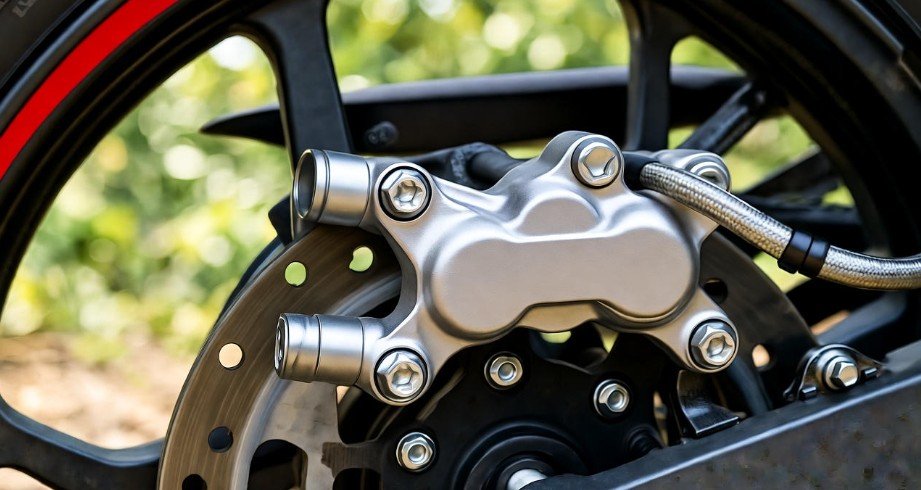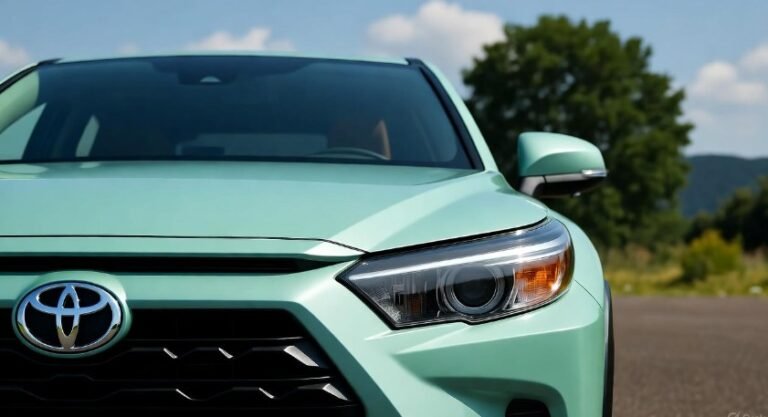Pulsar 220f Rear Disc Brake Caliper Price

The Pulsar 220f rear disc brake caliper price can range from around $30 to $100 for aftermarket parts, while genuine Bajaj parts may cost more. Factors like brand, quality, and seller influence the final cost.
Key Takeaways
Locate reliable sources for Pulsar 220f rear disc brake caliper pricing.
Understand genuine vs. aftermarket caliper options.
Factor in installation costs if you’re not doing it yourself.
Compare prices from different vendors for the best deal.
Consider the overall quality and warranty of the caliper.
Owning a Pulsar 220f is a thrilling experience, offering a blend of performance and style. When it comes to maintaining its impressive braking system, the rear disc brake caliper is a crucial component. You might be wondering about the Pulsar 220f rear disc brake caliper price, especially if you notice any issues or it’s time for a replacement. This guide is here to simplify that for you. We’ll break down what affects the cost, where to find the best deals, and what to look out for. Let’s get your ride stopping as powerfully as it goes.
Understanding Your Pulsar 220f Rear Disc Brake Caliper
Before diving into the price, it’s essential to understand what a rear disc brake caliper does. Think of it as the “grabbing hand” of your braking system. When you apply the rear brake, brake fluid pressure is sent to the caliper. Inside the caliper are pistons that push brake pads against the rotating brake disc (rotor). This friction slows down and stops your motorcycle.
The Pulsar 220f, a popular model known for its sporty performance, relies on a well-functioning rear disc brake caliper to ensure rider safety and control. A worn-out or damaged caliper can lead to reduced braking effectiveness, longer stopping distances, and potentially dangerous situations. Recognizing the signs of a failing caliper – such as a spongy brake lever, grinding noises, or uneven braking – is the first step towards addressing it.
Factors Influencing Pulsar 220f Rear Disc Brake Caliper Price
The cost of a Pulsar 220f rear disc brake caliper isn’t a single fixed number. Several factors contribute to the final price you’ll see at the checkout. Understanding these elements can help you make an informed decision and potentially save money.
1. Brand and Manufacturer
This is often the most significant factor.
Genuine Bajaj Parts: These are parts manufactured or approved by Bajaj Auto, the maker of the Pulsar 220f. They are designed to meet the exact specifications of your motorcycle, ensuring perfect fit and optimal performance. Genuine parts typically come with a higher price tag due to the brand’s reputation, quality control, and warranty.
Aftermarket Brands: Numerous companies produce aftermarket motorcycle parts. These can range from direct replacements that mimic genuine parts to performance-oriented upgrades. The price of aftermarket calipers can vary widely based on the brand’s reputation, the materials used, and their manufacturing processes. Some reputable aftermarket brands offer excellent quality at a more competitive price than genuine parts.
Generic/Unbranded Parts: These are usually the cheapest option. While they might seem like a good deal, their quality can be inconsistent. It’s often a gamble, and they may not last as long or perform as reliably as branded options.
2. Material and Construction Quality
The materials used to build the caliper body and its internal components (like seals and pistons) play a role in both performance and price.
Aluminum Alloys: Many calipers are made from aluminum alloys, which offer a good balance of strength, heat dissipation, and weight. Higher-grade alloys and advanced manufacturing techniques (like CNC machining) can increase the cost.
Steel: Some components, or even entire caliper bodies in older or very budget designs, might use steel. While durable, steel can be heavier and more prone to corrosion if not properly treated.
3. New vs. Reconditioned/Used Parts
New Calipers: These are brand-new units, offering the best reliability and lifespan. Naturally, they command the highest price.
Reconditioned Calipers: These are used calipers that have been professionally inspected, cleaned, and rebuilt with new seals and sometimes new pistons. They can offer a good balance of cost savings and reliability, but their lifespan might be shorter than a new unit.
Used Calipers: Sourced from salvaged motorcycles, these are the cheapest option. However, their condition can be highly variable, and there’s a risk they might have underlying issues. It’s generally recommended to avoid used calipers unless you’re an experienced mechanic who can thoroughly inspect them.
4. Seller and Location
Where you purchase the caliper can also affect the price.
Authorized Bajaj Dealerships: These will primarily stock genuine parts and may have fixed pricing.
Online Retailers: Websites like Amazon, eBay, or specialized motorcycle parts e-commerce stores often offer competitive pricing due to lower overheads and wider selection.
Local Motorcycle Shops: Independent repair shops may sell parts directly to customers, and their pricing can vary.
Geographic Location: Prices can differ slightly based on regional availability, shipping costs, and local economic factors.
Pulsar 220f Rear Disc Brake Caliper Price Range
To give you a clearer picture, let’s break down the typical price ranges you might encounter for a Pulsar 220f rear disc brake caliper. These are approximate figures and can fluctuate.
| Part Type | Estimated Price Range (USD) | Notes |
| :———————— | :————————– | :——————————————————————– |
| Genuine Bajaj Caliper | $60 – $150+ | OEM quality, guaranteed fit, often includes brand warranty. |
| Reputable Aftermarket | $30 – $80 | Good balance of price and quality, various brands available. |
| Budget Aftermarket | $20 – $40 | May offer basic functionality but potentially lower durability. |
| Reconditioned Caliper | $30 – $70 | Used, but rebuilt with new seals. Condition varies. |
| Used Caliper | $15 – $40 | Highest risk, inspect thoroughly before purchase. |
Note: These prices generally reflect the caliper assembly itself. They may or may not include brake pads, mounting bolts, or brake fluid, which are often sold separately. Always check the product description carefully.
Where to Buy Your Pulsar 220f Rear Disc Brake Caliper
Finding a reliable source for your Pulsar 220f rear disc brake caliper is key to getting a quality part at a fair price. Here are some of the best places to look:
1. Authorized Bajaj Service Centers and Dealerships
Pros: You are guaranteed to get genuine, OEM-spec parts. The technicians can also confirm if the caliper is indeed the problem and install it correctly.
Cons: Often the most expensive option. Limited selection of aftermarket choices.
2. Online Motorcycle Parts Retailers
Many dedicated online stores specialize in motorcycle parts and accessories. These often have a wide selection from various brands, competitive pricing, and detailed product descriptions. Some popular platforms include:
Partzilla: Known for OEM and aftermarket parts for many motorcycle brands.
RevZilla: Offers a curated selection of high-quality parts and accessories with excellent customer reviews and support.
BikeBandit: Another comprehensive online retailer for motorcycle components.
3. E-commerce Marketplaces
Platforms like Amazon and eBay are vast marketplaces where you can find both genuine and aftermarket parts, often from multiple sellers.
Pros: Huge variety, competitive pricing, easy price comparison, user reviews can be helpful.
Cons: Quality can vary significantly. It’s crucial to stick to reputable sellers with good return policies and to carefully read product descriptions and reviews to avoid counterfeit or low-quality items. Look for sellers specializing in motorcycle parts.
4. Local Motorcycle Repair Shops
Your neighborhood mechanic often has access to parts suppliers and can also perform the installation.
Pros: Convenient if you need installation done by a trusted mechanic. They might offer bundled deals (part + labor).
Cons: Pricing can sometimes be higher than online options due to overheads.
Checking for Quality and Authenticity
When purchasing a Pulsar 220f rear disc brake caliper, especially an aftermarket one, it’s wise to be vigilant about quality and authenticity.
Read Reviews: Pay close attention to customer reviews and ratings on online platforms. Look for consistent feedback regarding performance, durability, and ease of installation.
Check Seller Reputation: On marketplaces like eBay or Amazon, look at the seller’s history, ratings, and return policy.
Inspect Packaging: Genuine and reputable aftermarket parts usually come in well-designed, branded packaging. Poorly printed logos, flimsy boxes, or generic labeling can be red flags.
Look for Brand Markings: The caliper itself should have clear brand markings or part numbers. If these are absent or look unprofessional, it might be a sign of a counterfeit product.
Warranty Information: Reputable manufacturers and sellers will offer a warranty on their parts. Ensure you understand the warranty terms before purchasing.
DIY Installation vs. Professional Service
The Pulsar 220f rear disc brake caliper price is one part of the total cost; installation is another. You have two main options:
1. DIY Installation
If you’re comfortable with basic motorcycle maintenance and have the right tools, you can save money by replacing the caliper yourself.
Tools You Might Need:
Wrenches (metric sizes, typically 8mm, 10mm, 12mm)
Allen keys/hex wrenches
Torque wrench (highly recommended for proper tightening)
Brake cleaner
Brake fluid (DOT 3 or DOT 4, check your manual for the correct type)
Syringe or brake bleeding kit
Gloves and eye protection
Shop rags
Basic Steps:
1. Safety First: Ensure the motorcycle is on a stable stand. Wear protective gear.
2. Remove Old Caliper: Disconnect the brake line and any sensor wires if present. Unbolt the caliper from its mounting bracket.
3. Prepare New Caliper: Transfer any necessary hardware from the old caliper or install new ones. Check that the pistons move freely.
4. Install New Caliper: Mount the new caliper to the bracket and tighten bolts to the manufacturer’s specified torque. Reconnect the brake line securely.
5. Bleed Brakes: This is a critical step. Open the bleed screw on the caliper and pump the brake lever while adding fresh brake fluid to the reservoir. Continue until all air is purged from the system and the brake lever feels firm. Refer to the official Bajaj Pulsar 220f service manual for detailed bleeding procedures.
6. Test Brakes: Carefully test the rear brake at low speed in a safe area before riding normally.
2. Professional Installation
If you’re not mechanically inclined or don’t have the tools, taking it to a professional is the best route.
Pros: Ensures the job is done correctly and safely. Professional mechanics have specialized tools and knowledge. Often comes with a labor warranty.
Cons: Adds to the overall cost. Labor rates can vary significantly between shops.
The cost of professional installation can range from $50 to $150, depending on the shop’s labor rates and the time it takes.
Pro Tip:
Always use fresh, the correct type of brake fluid as specified in your Pulsar 220f owner’s manual. Old or contaminated fluid can degrade brake performance and damage components.
When Should You Replace Your Rear Disc Brake Caliper?
It’s not just about price; it’s about knowing when to replace it. Here are common indicators:
Spongy or Soft Brake Lever: If the brake lever feels mushy and travels too far towards the handlebar, it often indicates air in the brake lines or a failing caliper seal.
Leaking Brake Fluid: Any visible leaks around the caliper body or pistons are a clear sign of damage and require immediate replacement.
Grinding or Squealing Noises: While often related to brake pads, persistent, unusual noises originating from the caliper area can point to worn internal components or a caliper issue.
Uneven or Weak Braking: If the rear wheel doesn’t brake evenly or feels significantly weaker than usual, the caliper might be sticking or damaged.
Corrosion or Physical Damage: Significant rust, bent components, or damage to the caliper body can compromise its function and safety.
* Sticking Caliper: If the brake drags even when not applied, the caliper pistons might not be retracting properly, leading to increased wear and reduced speed.
Frequently Asked Questions (FAQ)
Q1: How much does a Pulsar 220f rear disc brake caliper usually cost?
A1: The Pulsar 220f rear disc brake caliper price typically ranges from $30 to $150 or more, depending on whether it’s a genuine Bajaj part, an aftermarket brand, or a used component.
Q2: Are aftermarket rear disc brake calipers for the Pulsar 220f reliable?
A2: Many aftermarket calipers from reputable brands are reliable and offer good value. However, it’s crucial to choose brands known for quality and read customer reviews to ensure performance and durability.
Q3: Does the Pulsar 220f rear disc brake caliper price include brake pads?
A3: It often depends on the specific product listing. Some calipers come pre-assembled with pads, while others are sold as the caliper body only. Always check the product description carefully before purchasing.
Q4: Can I replace the rear disc brake caliper myself on a Pulsar 220f?
A4: Yes, if you have the necessary tools and basic mechanical knowledge. However, properly bleeding the brake system is a critical step that requires care and attention to ensure optimal braking performance and safety.
Q5: Where is the best place to buy a Pulsar 220f rear disc brake caliper online?
A5: Reputable online motorcycle parts retailers like Partzilla, RevZilla, or trusted sellers on platforms like Amazon and eBay are good options. Look for sellers with high ratings and clear return policies.
Q6: What happens if I don’t replace a faulty rear disc brake caliper?
A6: A faulty caliper can significantly reduce your motorcycle’s braking ability, increasing stopping distances and posing a serious safety risk. It can also lead to uneven wear on the brake disc and pads.
Q7: How can I tell if my Pulsar 220f rear brake caliper needs replacing?
A7: Signs include a spongy brake lever, fluid leaks around the caliper, grinding noises, or noticeably weaker rear braking performance.
Conclusion
Maintaining your Pulsar 220f’s braking system is paramount for your safety and riding enjoyment. Understanding the Pulsar 220f rear disc brake caliper price, the factors that influence it, and where to source reliable parts empowers you to make the best decision for your motorcycle. Whether you opt for a genuine Bajaj part or a quality aftermarket alternative, ensuring your caliper is in good working order will keep you confidently stopping on every journey. By staying informed and choosing wisely, you can keep your Pulsar 220f performing at its best for years to come.






